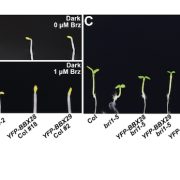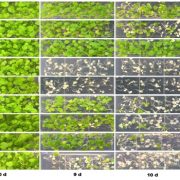Methyltransferase TaSAMT1 mediates wheat freezing tolerance by integrating brassinosteroid and salicylic acid signaling
 Temperature extremes, such as cold stress, severely affect wheat (Triticum aestivum) productivity and quality by impairing its vegetative and reproductive growth. Several phytohormones have roles in cold stress, such as brassinosteroids (BRs) and salicylic acid (SA). However, how BR interacts with SA in response to cold stress remains unknown. In this work, Chu et al. describe the role of an SA methyltransferase named TaSAMT1 and its function in conferring freezing tolerance in wheat. They demonstrated that TaSAMT1 converts SA to methyl SA (MeSA), a volatile form of SA that acts as a signal molecule in plant responses to abiotic stress. Through various experiments, including use of Arabidopsis thaliana knock-out and overexpressing mutant lines, they established a role of MeSA in the response to freezing tolerance in wheat. In addition, they elucidated how SA and BRs pathways interact in the regulation of freezing tolerance. Specifically, they found that BRASSINAZOLE-RESISTANT 1 (TaBZR1) directly interacts with the TaSAMT1 promoter, inducing its transcription. Finally, TaBZR1 also interacts with TaHAG1, a histone acetyltransferase that enhances TaSAMT1 expression via histone acetylation but it also interacts with TaHAG1, a histone acetyltransferase that enhances TaSAMT1 expression via histone acetylation. This work suggests that TaSAMT1 might be a target for selection and breeding for improving wheat cold tolerance. (Summary by Eva Maria Gomez Alvarez, @eva_ga96 @eva_ga96) Plant Cell 10.1093/plcell/koae100
Temperature extremes, such as cold stress, severely affect wheat (Triticum aestivum) productivity and quality by impairing its vegetative and reproductive growth. Several phytohormones have roles in cold stress, such as brassinosteroids (BRs) and salicylic acid (SA). However, how BR interacts with SA in response to cold stress remains unknown. In this work, Chu et al. describe the role of an SA methyltransferase named TaSAMT1 and its function in conferring freezing tolerance in wheat. They demonstrated that TaSAMT1 converts SA to methyl SA (MeSA), a volatile form of SA that acts as a signal molecule in plant responses to abiotic stress. Through various experiments, including use of Arabidopsis thaliana knock-out and overexpressing mutant lines, they established a role of MeSA in the response to freezing tolerance in wheat. In addition, they elucidated how SA and BRs pathways interact in the regulation of freezing tolerance. Specifically, they found that BRASSINAZOLE-RESISTANT 1 (TaBZR1) directly interacts with the TaSAMT1 promoter, inducing its transcription. Finally, TaBZR1 also interacts with TaHAG1, a histone acetyltransferase that enhances TaSAMT1 expression via histone acetylation but it also interacts with TaHAG1, a histone acetyltransferase that enhances TaSAMT1 expression via histone acetylation. This work suggests that TaSAMT1 might be a target for selection and breeding for improving wheat cold tolerance. (Summary by Eva Maria Gomez Alvarez, @eva_ga96 @eva_ga96) Plant Cell 10.1093/plcell/koae100








